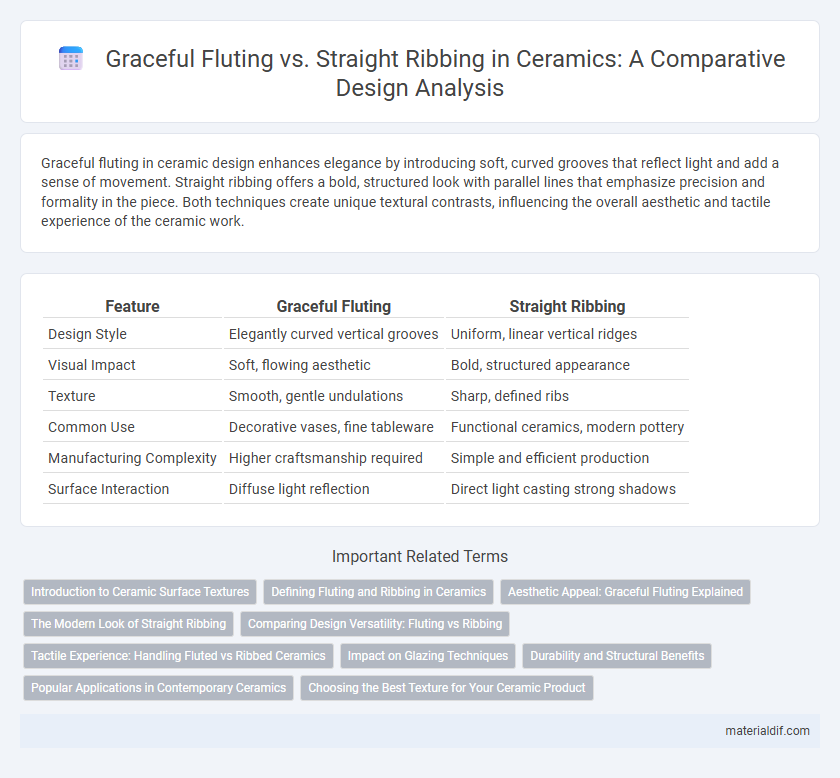Graceful fluting in ceramic design enhances elegance by introducing soft, curved grooves that reflect light and add a sense of movement. Straight ribbing offers a bold, structured look with parallel lines that emphasize precision and formality in the piece. Both techniques create unique textural contrasts, influencing the overall aesthetic and tactile experience of the ceramic work.
Table of Comparison
| Feature | Graceful Fluting | Straight Ribbing |
|---|---|---|
| Design Style | Elegantly curved vertical grooves | Uniform, linear vertical ridges |
| Visual Impact | Soft, flowing aesthetic | Bold, structured appearance |
| Texture | Smooth, gentle undulations | Sharp, defined ribs |
| Common Use | Decorative vases, fine tableware | Functional ceramics, modern pottery |
| Manufacturing Complexity | Higher craftsmanship required | Simple and efficient production |
| Surface Interaction | Diffuse light reflection | Direct light casting strong shadows |
Introduction to Ceramic Surface Textures
Graceful fluting in ceramic surface textures features gently curved, vertical grooves that enhance visual elegance and tactile appeal, creating a dynamic interaction of light and shadow. Straight ribbing consists of uniform, parallel ridges that provide a structured, modern aesthetic and improved grip, often used in functional wares. Both textures influence the ceramic's overall appearance and usability by adding dimensionality and enhancing the sensory experience.
Defining Fluting and Ribbing in Ceramics
Fluting in ceramics refers to the shallow, concave grooves that add texture and elegance to pottery surfaces, enhancing both aesthetic appeal and grip. Ribbing consists of raised, linear ridges that create tactile contrast and structural reinforcement on ceramic pieces. Both fluting and ribbing serve functional and decorative purposes, influencing the visual rhythm and form of ceramic art.
Aesthetic Appeal: Graceful Fluting Explained
Graceful fluting in ceramics features smooth, tapered grooves that create a sense of elegance and fluidity, enhancing the tactile and visual appeal of the piece. This technique contrasts with straight ribbing, which presents uniform, linear ridges that convey a more modern and structured aesthetic. The subtle curvature of graceful fluting adds depth and sophistication, making it a preferred choice for decorative ceramics aiming to evoke classic beauty and refined craftsmanship.
The Modern Look of Straight Ribbing
Straight ribbing in ceramics offers a sleek, contemporary aesthetic that enhances minimalist and modern interior designs. Its uniform, linear texture creates a sense of order and sophistication, making it a popular choice for cutting-edge architectural ceramics. This design emphasizes clean lines and simplicity, aligning seamlessly with modern trends in ceramic art and production.
Comparing Design Versatility: Fluting vs Ribbing
Graceful fluting in ceramics offers a dynamic play of light and shadow, creating an elegant texture that enhances curvilinear forms and adds a sense of movement to the design. Straight ribbing provides a more structured, linear aesthetic, delivering uniformity and precision that complements minimalist or modern styles. Both techniques enable distinct design versatility, with fluting emphasizing organic flow and ribbing emphasizing architectural clarity.
Tactile Experience: Handling Fluted vs Ribbed Ceramics
Fluted ceramics offer a delicate, flowing texture that enhances the tactile experience by creating gentle ridges that encourage a smooth, comfortable grip. Straight ribbing provides a more structured, linear feel, delivering a firm and precise hold ideal for functional use. Both textures influence how the ceramic interacts with the skin, impacting the overall sensory satisfaction during handling.
Impact on Glazing Techniques
Graceful fluting in ceramics creates gentle grooves that enhance glaze pooling and variation, producing rich, textured finishes with depth. Straight ribbing offers uniform channels that guide glaze flow predictably, resulting in consistent surface patterns and smooth transitions. The choice between fluting and ribbing directly impacts glaze behavior, influencing the final aesthetic and tactile qualities of ceramic pieces.
Durability and Structural Benefits
Graceful fluting in ceramic designs enhances durability by evenly distributing stress across curved surfaces, reducing the likelihood of cracks and chips under pressure. Straight ribbing, characterized by linear patterns, reinforces structural integrity by providing additional support along specific stress points, making ceramics more resistant to impact and deformation. Both techniques improve longevity, but fluting offers superior resistance to bending forces while ribbing excels in maintaining rigidity against compressive loads.
Popular Applications in Contemporary Ceramics
Graceful fluting in ceramics is prized for its delicate curvature, often featured in decorative vases and elegant tableware, enhancing tactile and visual appeal. Straight ribbing, with its linear precision, is widely used in functional pottery and modern architectural tiles to create a sleek, structured aesthetic. Contemporary ceramic artists frequently blend both techniques to achieve dynamic surfaces that balance softness with geometric clarity.
Choosing the Best Texture for Your Ceramic Product
Graceful fluting creates delicate, curved grooves that enhance the tactile appeal and reflect light softly, ideal for elegant ceramic vases or refined tableware. Straight ribbing features linear, uniform ridges that provide a modern, structured look and improve grip, making it suitable for functional ceramics like mugs or storage jars. Selecting between fluting and ribbing depends on the desired aesthetic impact and practical use, with fluting favoring sophistication and ribbing emphasizing durability and handling.
Graceful Fluting vs Straight Ribbing Infographic

 materialdif.com
materialdif.com